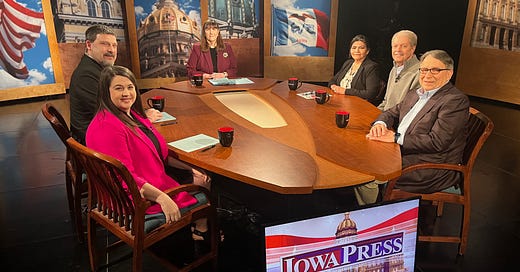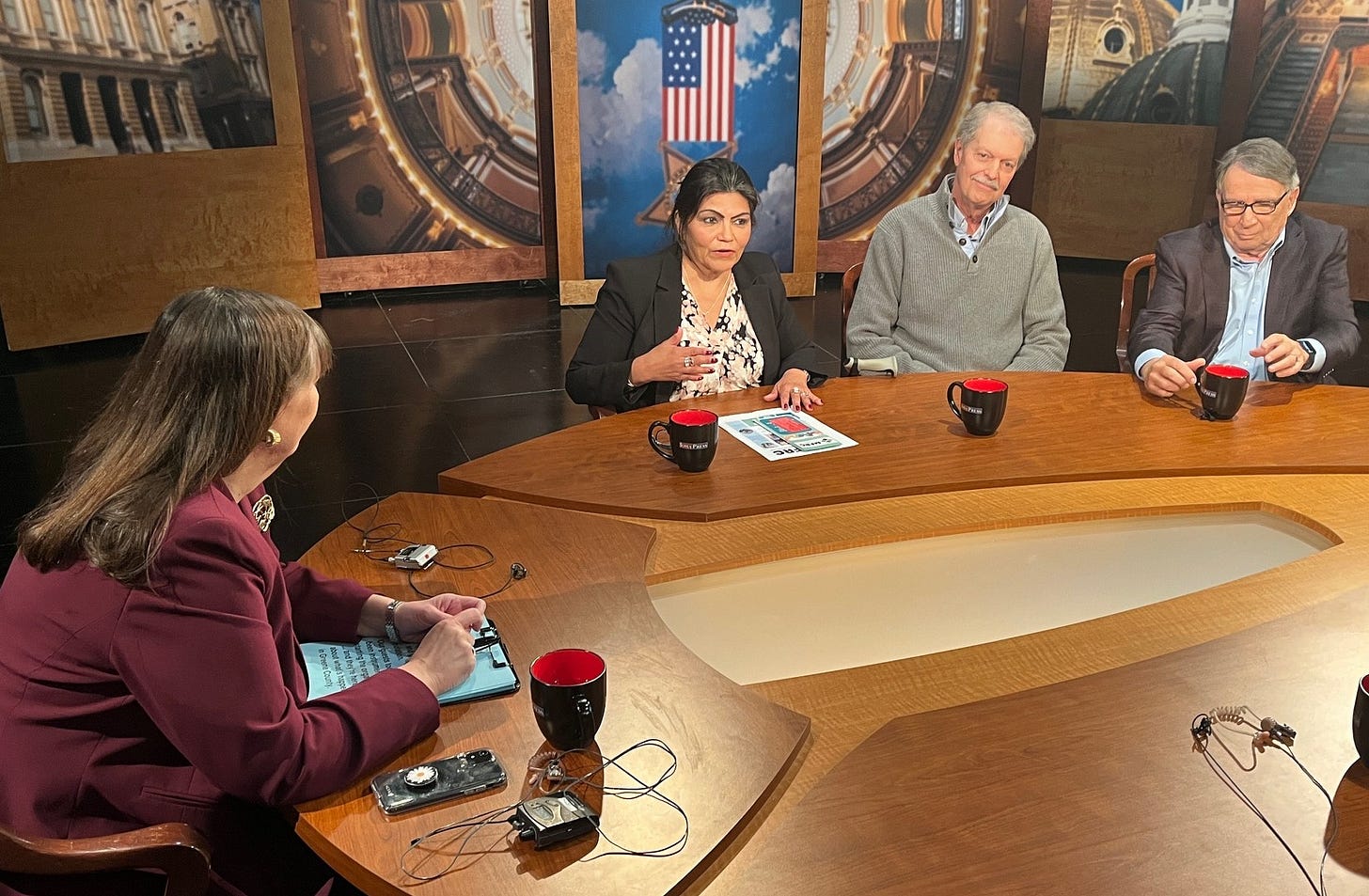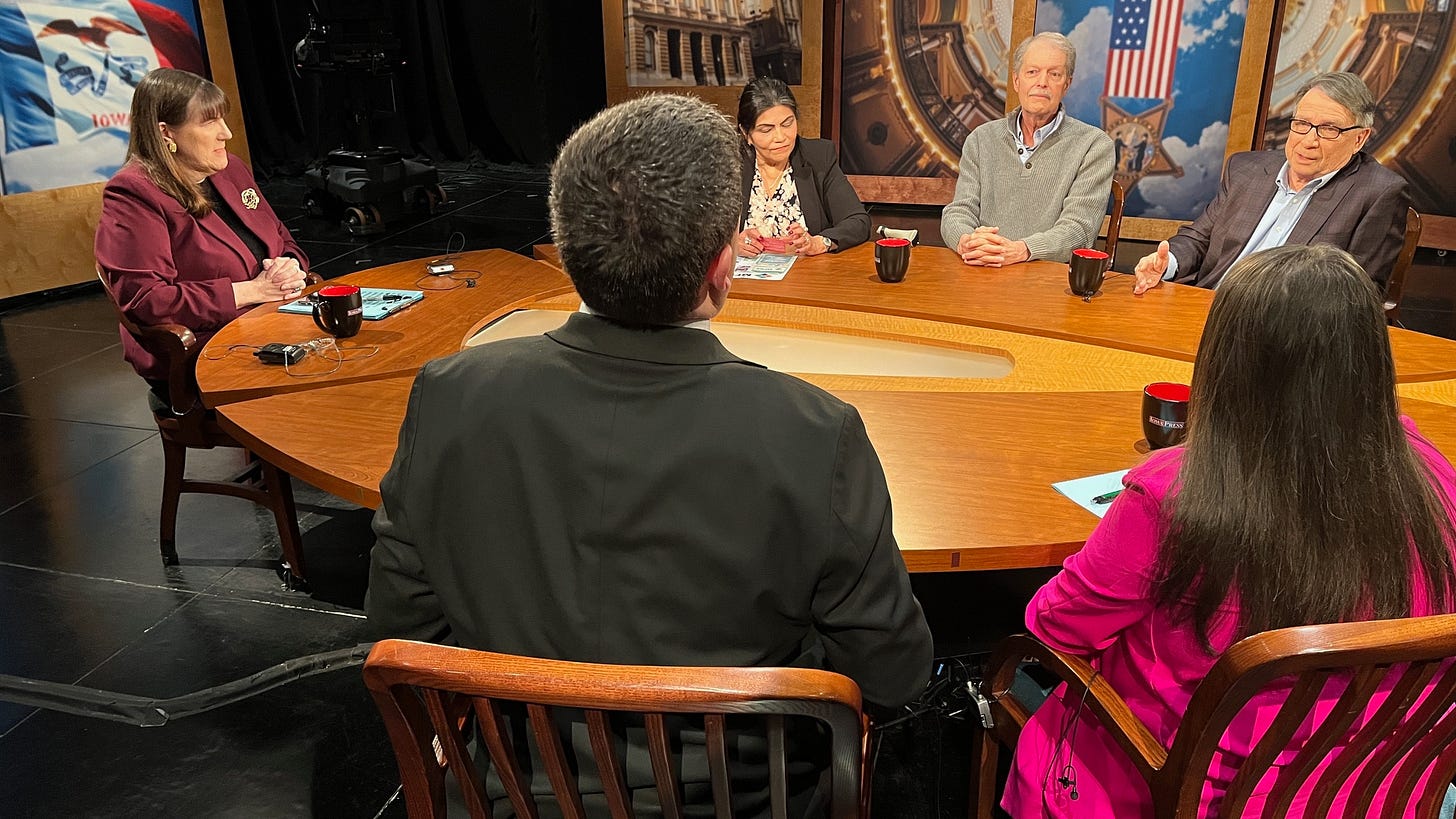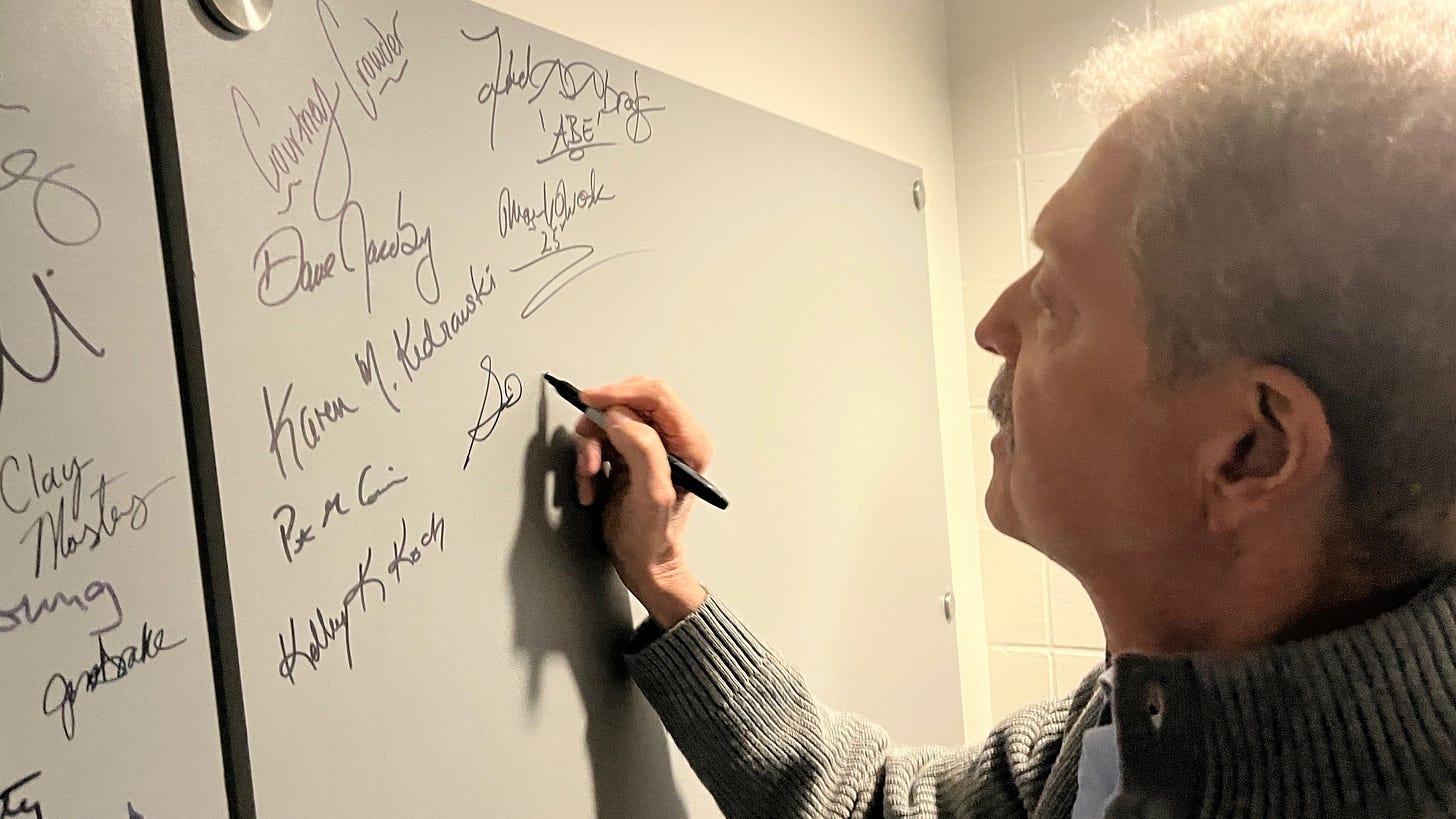Where diversity is a darned good story
The Iowa PBS show “Iowa Press” invited three of us to explain Greene County’s initiative for growth & diversity, the “Multicultural Family Resource Center.”
JOHNSTON, Iowa – I said it on statewide public television this weekend, and the more I’ve thought about it after the studio lights dimmed, the prouder I am to say it again: The initiative for growth & diversity that the Greene County Development Corporation, our economic development group, launched nearly four years ago “is working well.”
You can’t make a statement like that in front of a good reporter like Kay Henderson without getting a follow-up question. Henderson is the host of the “Iowa Press” show on Iowa PBS and is also the veteran news director of Radio Iowa. She was asking me because I was the chairperson of the initiative’s steering committee for 2 ½ years, and I’m still one of its noisiest advocates.
Ready for the start of the May 2 “Iowa Press” show on Iowa PBS. Clockwise from the left front are Brianne Pfannenstiel of the Des Moines Register, Erin Murphy of the Cedar Rapids Gazette, the show’s host Kay Henderson, and the three guests from Greene County — there to discuss the county’s “Multicultural Family Resource Center — director Sara Huddleston, board member Sid Jones and advocate Chuck Offenburger. (Iowa PBS photos by Dave Miller)
“So…how many of the jobs have been filled?” Henderson asked. “…what does the data show?”
We had reported earlier that our major employers in Greene County had at least 120 open jobs when our work began in 2021 on what we now call the “Multicultural Family Resource Center.”
Sara Huddleston, who last June became the bi-lingual director of the new center, started to answer the question, saying she recently worked with one of our industries needing translation services. That led that one company to hire “a couple” of Spanish-speaking employees. She went on to another thought, perhaps leaving some viewers with the impression that our 4-year, county-wide effort had produced only “a couple” new workers.
Not so. The growth of Greene County’s total workforce, and the increase in our population’s diversity, has been much more significant, as I explained when Henderson re-directed her question to me.
“…we used to say that when we started this program there were 300 Latino people (already) in Greene County,” I said. “…that number is now growing. Keep in mind, one other thing is we've had farmers in Greene County use Latino workers as guest workers for 25 years. Deal's Orchard has done that, one of our iconic attractions. And so, I would say overall we probably have about 100 to 150 newcomers in the county since we started this program…”
Nearly all have found work – at better jobs than they had wherever they lived previously.
You can watch this edition of “Iowa Press” on the Iowa PBS website by clicking on this link.
Sara Monroy Huddleston, director of the Multicultural Family Resource Center, describes the work she does in the schools, businesses, communities and organizations in Greene County, which is located about 50 miles west and north of Des Moines. She came to Greene County after 30 years of community leadership on matters of diversity in Storm Lake, where she also served three terms on the City Council. She is a native of Merida, the capital city of the Yucatan state in Mexico. She first came to Iowa to attend Simpson College, where she graduated and met her husband Matt Huddleston. (Iowa PBS photo)
Do I hear some doubters?
Go to Greene County High School, in Jefferson, and look at a student body that is clearly two or three times more diverse than it was, say, five years ago. The middle and elementary schools are even more diverse.
I now count eight or nine of our major employers in the county, plus 60 or more farm & livestock operations, that have hired newcomers whose heritage is in at least eight different countries.
Want to check me on that? Here are the companies: New Way Trucks in Scranton; Bauer Built Manufacturing and John Deere in Paton; Neese Inc. in Grand Junction; Landus all over the county; and in the county seat of Jefferson, Power Lift, maybe American Athletic, Greene County Medical Center, and Wild Rose Casino & Resort. The products of the manufacturers range from Olympics gymnastics equipment, NBA basketball goals and rims, weight-lifting equipment used by the best pro and college sports teams, fantastic farm equipment, and garbage & recycling trucks used around the world.
The newer workers I’m talking about have heritages in Mexico, Canada, Cuba, Honduras, Guatemala, Ukraine, Vietnam, South Africa, and there may be some coming from the Middle East.
It’s a darned good story, I keep telling people, one that is happening in a rural Iowa county where the population a century ago pushed 20,000 but today is about 8,700. That’s a plight common in maybe two-thirds of the counties in the Iowa countryside.
Greene County is trying to prove that it’s different.
Chuck Offenburger talking about the challenge of having enough housing in rural communities that want to grow. (Iowa PBS photo)
“Diversity can be a divisive word these days,” Henderson said in opening the “Iowa Press” show taped on Friday, May 2. “But one rural Iowa county is welcoming newcomers to help boost its economy… We'll talk to leaders in Greene County about what they're doing…”
One of the show’s panelists, Brianne Pfannenstiel, chief political reporter for the Des Moines Register, noted that “you guys come from a pretty conservative corner of the state. This is a county that voted to re-elect Donald Trump by a 2 to 1 margin in this last election. Sid Jones, how has this been received by the community? How has this initiative been received?”
Jones, semi-retired, had been the highly-respected president of Home State Bank in Jefferson, as well as president of the county’s economic development organization. He still serves on the board of directors of the new Multicultural Family Resource Center.
“I think it has been received very, very well,” he began – and I note here that these extended quotations are taken from the transcript of Iowa Press shows that Iowa PBS provides on its website. “…change is hard, really hard for rural Iowa. And from the very beginning (of the diversity initiative), we concentrated on whole families, not just individual workers, and we concentrated on documented families. And so, we haven't had an explosion (of newcomers from other cultures). We didn't expect that we would. And it's a slow growth.
“But we've had a good growth… We also, from the very beginning, had ‘town hall meetings,’ we called them. We went to every community in the county, two (meetings) in Jefferson plus the other five, we had seven total. And we just sat down with people and talked about it. It was very open.”
Sid Jones signs the “Iowa Press” guests’ wall in the hallway outside the studio. The autographs from guests are part of the long-running show’s traditions. (Iowa PBS photo)
One of the moderators of those meetings was Carlos Arguello, of Grimes, Iowa, whom the economic development group had hired as a consultant on growth & diversity. Arguello, who was born in Nicaragua, had grown up in the western Iowa town of Carroll. He graduated from Carroll High School, majored in business at the University of Northern Iowa, then worked 13 years in international business with John Deere. As he saw the diversity growing in Iowa’s population, he decided to start his own company to assist large businesses, political campaigns, communities and then Greene County to recruit people from other cultures, especially Latinos, the fastest-growing population demographic in both Iowa and the U.S.
“Carlos was a big part of those town hall meetings for us,” Jones continued. “He grew up in the Latino culture, he understood it. At that point we were kind of concentrating on Latino (families), but it really expanded from that to multicultural. But he talked about the values of the Hispanic population. Number one is family, number two is faith, number three is fun. He said, ‘If I look at the ancestors of Greene County, the very same thing. They came from all over the world. They were diverse. They also all had that same moral background, though.’ And he said, that's the moral background that a lot of the Latino population, in particular, would bring here. As he talked about that culture, I think the threat kind of went away and (our people) realized that we do have a need. We have to help solve this (workforce) problem or we're going to have a critical problem.”
An indication of the community support came when a public fund drive for $300,000 – to go with a $95,000 U.S. Department of Agriculture community development grant – was quickly successful.
It became clear, as ideas for the multicultural initiative developed, that if Greene County would add significantly to its population – in order to grow the workforce – finding enough housing would be a real challenge, as it is in so many Iowa small towns.
Erin Murphy, another “Iowa Press” panelist who is the Des Moines news bureau chief for the Cedar Rapids Gazette, asked me how we’re meeting that housing challenge.
“Finally, we're turning a corner,” I answered. “For years, Jefferson averaged building three new houses a year – just three new houses a year! And we just could not get outside contractors to come in. We tried to interest our local contractors in expanding, but they had the same problem all of our businesses in Greene County had – they couldn't hire enough workers.
“So, we had to look at trying to find outside contractors and it took a long time. Finally, Andy Rowland, a guy from the Des Moines area, Urbandale actually, came in. He had a small business, just getting started building houses and duplexes and apartments, and (heard about the need in Greene County). Andy has now built 17 residential units in the county. Then Greene County was named a ‘Thriving Community’ by the Iowa Economic Development Authority, and that opened up workforce tax credits that contractors could get in Greene County. That spread the word among other contractors, and now we finally have several of them coming in.
“It’s happening slowly, slower than we'd want, but it is happening. We have a 40-unit apartment complex that they're going to start on this summer. It's just in the north part of town. We have fill-in housing projects from two or three different contractors. But in addition to Jefferson, we have the five other towns that are spread around the county. Keep in mind that three of our larger industries are in the little towns of Paton or Scranton. We need housing development in those communities too.
“So, because this is a workforce growth initiative in addition to being a diversity initiative, there is a realistic opportunity here for all of the Greene County towns to grow again, which I think is really exciting. And (to find people to move here) we have to go where the growth is, and the growth is in the newcomer population. All over Iowa you can see that. And as we've gone into this, I've said it's an exciting idea -- that we're going to have a multicultural workforce using the Iowa work ethic to produce for the global market.”
Sara Huddleston autographed the “Iowa Press” hallway wall, too. (Iowa PBS photo)
Gazette reporter Murphy then closed the questioning with a big one for our multicultural center director Huddleston.
“This effort is working against some very serious headwinds that Kay (Henderson) talked about at the top of the show,” Murphy said. “The trend in recent years has been people moving away from areas like Greene County towards the urban centers. What is your -- what gives you reason for optimism that this program will -- you've talked about small success so far -- what makes you hopeful that that success will continue and grow?”
She didn’t wince at all. In fact, she smiled.
“I base it on my experience back in Storm Lake when I started,” Huddleston said. “I was it! I was the only Latina woman in town at that time. It was in 1989 or 1990. And then when I left, there was people from all over the world and 40 languages. So, my belief is that I am now in a town, Jefferson, which is very lucky to have all of these industries in the middle, again, of nowhere.
“It is a very unique town, progressive town. I believe that with me moving there, which I always tell the guys, ‘Are you ready?’ I believe the people are going to follow. They tend to follow Sara for some reason. I don't know what I do, but every time I go someplace, the number goes up fast. And I told the guys, ‘Are you ready?’ That was my first question because I knew, I'm not blind, I know that some people are not ready.
“But I knew where I was going to go and I thought, ‘I'm ready for a challenge and I'm going to do it!’ Based on my experience, the work that I had done, assimilated and integrated to Iowa, I love the work ethic of the state and how the people are. I think they've got a great opportunity. Why miss that great opportunity that we have in Greene County?”
Chuck Offenburger, after his face was prepped by Iowa PBS make-up artist Shelly Banks. Note she used enough powder and coloring to cover the “Bean Barnacle” on the left side of his forehead as you look at the photo. The barnacle is named in honor of his dermatologist, Dr. Andy Bean, who won’t remove it, so the columnist named it after him. Make-up artist Banks even trimmed the eyebrows of the writer, requiring much more time on him than she did on either Sara Huddleston or Sid Jones. (Photo by Sid Jones)
--
You can comment on this column below or write the columnist directly by email at chuck@offenburger.com
--
Have you explored the variety of writers, plus Letters from Iowans, in the Iowa Writers’ Collaborative? They are from around the state and contribute commentary and feature stories of interest to those who care about Iowa. Please consider a paid subscription. It helps keep them going, and it keeps you in the know.










Chuck, that’s the kind of Iowa I’m proud to be from! Thank you to Greene County and to you for letting us know about it.
Don’t try to tell Greene county that diversity isn’t a valued aspect of civic life. Onward 🙌🏼